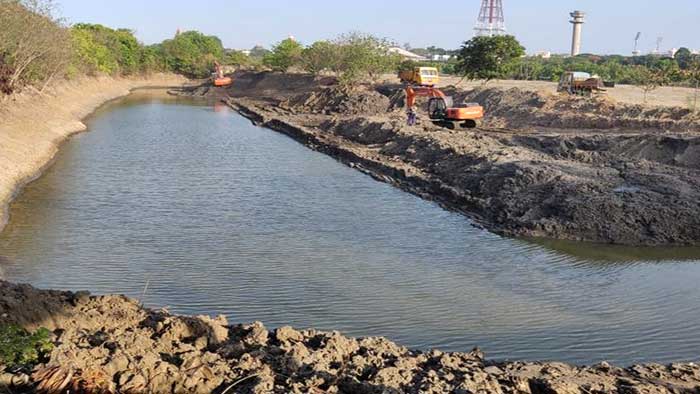Once water-starved, Chennai's Cantonment area and military station now boast of 13 brimful water bodies and recycling plants, and also generate their own electricity. Inspired by the innovation, the Ministry of Defence has directed its Estate Wing to implement the development work across all defence establishments.
The ministry has suggested Directorate General, Defence Estates (DGDE), an inter-services organisation of the ministry which directly controls the cantonment administration, to replicate the Chennai Cantonment area development model.
Water bodies -- 13 in all-- are revived and a water recycling mechanism was put in place at both Cantonment Board St. Thomas Mount cum Pallavaram and Military Station, where there was an acute shortage of water in 2018.
A senior Indian Defence Estates Service (IDES) officer said that additional storage space for two-crore-litre water was created. "Further, because of recycling plant, 2 lakh liters of treated water is used in these areas per day," the officer said.
The board also created a waste management system where door-to-door collection of garbage is being carried out and then segregated into bio degradable and non-biodegradable. It is then treated in a bio-compost pit. Thereafter, biodegradable waste is put in centralised processing wind row system and then manure is created and made available for sale.
The board revived a green zone with around 2,000 plantations, set up solar power plants and a sewage treatment plant.
The solar power infrastructure set up in a year had generated electricity worth Rs 1 crore which is distributed within the cantonment areas.
Interestingly, the board has created a separate dumping zone for plastic bags. The board came up with an innovative idea of retrieval of ration milk and meat poly packets from consumers. It formalised collection and disposal, prevented littering and reaped financial benefits.
A senior Indian Army officer said the innovative idea was of Lieutenant General S.T. Upasani, who was the General Officer Commanding (GOC) of Dakshin Bharat Area. Lt Gen Upasani recently took charge as Director General of Information System, the crucial post in Indian Army which was lying vacant for the last two months.
Further, the board carried out campaign to revive green zone and planted 2,022 trees with 98 per cent survivability.
This development model is set to be replicated at 61 cantonments areas across the country that had been notified under the Cantonments Act, 1924, which was succeeded by the Cantonments Act, 2006. There are 62 cantonment areas. The overall municipal administration is managed by the cantonment boards, which are democratic bodies.
The ex officio president of the board is the station commander and the Chief Executive Officer, who is also the Member-Secretary of the Board, is an officer of the IDES or Directorate General, Defence Estates (DGDE).


INDI alliance loses ground, resorts to false allegations: CM*
Chief Minister Prof. Dr. Manik Saha said on Friday that the INDI alliance has lost its ground, leading them to resort to making false and misleading allegations. Dr. Saha said this while traveling by train to participate in election programs in North District and Unakoti District.
Tripura records highest 79.83 pc voter turnout in Northeast
Tripura witnessed around 79.83 per cent voter turnout registered till 5 p.m. in the Tripura West Lok Sabha seat on Friday in the first of the seven-phased general polls, as per the data provided by the Election Commission of India (ECI).
Amid sporadic incidents of violence, Manipur's two LS seats record 68 per cent voting
Amidst stray incidents of violence, including vandalisation of polling booths, firing, and clashes, around 68 per cent of 15.44 lakh voters cast their votes in two Lok Sabha seats (one partially) in ethnic violence-hit Manipur on Friday, officials said.
LS polls: Assam records 70.65 pc voting till 5 pm; 69.91 pc turnout in Meghalaya
Assam has recorded 70.65 per cent voter turnout till 5 p.m. on Friday, officials said. Five Lok Sabha seats in Assam -- Dibrugarh, Jorhat, Kaziranga, Lakhimpur, and Sonitpur -- went to the polls in the first phase.
Brahmos delivery to Philippines realises PM Modi's vision of expanding Bharat's defence footprint
It was in January 2022 that the BrahMos Aerospace Private Limited (BAPL) signed a $374.9 million contract with the Department of National Defence of the Republic of Philippines that included supply of shore-based anti-ship missile systems for the Philippines Navy.
Northeast records over 50 pc voting till 3 pm despite inclement weather
In Arunachal - which is going for simultaneous Lok Sabha and Assembly elections - the Arunachal East parliamentary seat recorded a voter turnout of 56.78 per cent and the Arunachal West Lok Sabha seat witnessed 54.53 per cent voter turnout till 3 PM.
Tripura records 68.11% voter turnout till 3 PM
The electoral process for the initial phase in the West Parliamentary Constituency of Tripura commenced at 7 AM, bolstered by stringent security measures. By 3 PM, the voter turnout stood at 68.11%.
Pak-born Bangladeshi national held in Tripura with Indian documents
A 25-year-old man was arrested in Tripura while attempting to cross into Bangladesh illegally, officials said here on Friday, adding that he claimed to be a Pakistani-born Bangladeshi national who had travelled across India.